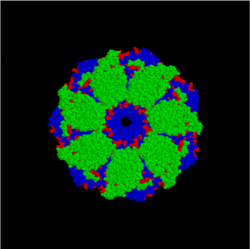
Back شابرون (بروتين) Arabic Šaperon BS Xaperona Catalan Chaperon Czech Chaperon (Protein) German Ĉaperono Esperanto Proteína chaperona Spanish Šaperonid Estonian شپرون Persian Saperoni Finnish

In molecular biology, molecular chaperones are proteins that assist the conformational folding or unfolding of large proteins or macromolecular protein complexes. There are a number of classes of molecular chaperones, all of which function to assist large proteins in proper protein folding during or after synthesis, and after partial denaturation. Chaperones are also involved in the translocation of proteins for proteolysis.
The first molecular chaperones discovered were a type of assembly chaperones which assist in the assembly of nucleosomes from folded histones and DNA.[1][2] One major function of molecular chaperones is to prevent the aggregation of misfolded proteins, thus many chaperone proteins are classified as heat shock proteins, as the tendency for protein aggregation is increased by heat stress.
The majority of molecular chaperones do not convey any steric information for protein folding, and instead assist in protein folding by binding to and stabilizing folding intermediates until the polypeptide chain is fully translated. The specific mode of function of chaperones differs based on their target proteins and location. Various approaches have been applied to study the structure, dynamics and functioning of chaperones. Bulk biochemical measurements have informed us on the protein folding efficiency, and prevention of aggregation when chaperones are present during protein folding. Recent advances in single-molecule analysis[3] have brought insights into structural heterogeneity of chaperones, folding intermediates and affinity of chaperones for unstructured and structured protein chains.
- ^ Richardson RT, Alekseev OM, Grossman G, Widgren EE, Thresher R, Wagner EJ, et al. (July 2006). "Nuclear autoantigenic sperm protein (NASP), a linker histone chaperone that is required for cell proliferation". The Journal of Biological Chemistry. 281 (30): 21526–34. doi:10.1074/jbc.M603816200. PMID 16728391.
- ^ Alekseev OM, Richardson RT, Alekseev O, O'Rand MG (May 2009). "Analysis of gene expression profiles in HeLa cells in response to overexpression or siRNA-mediated depletion of NASP". Reproductive Biology and Endocrinology. 7: 45. doi:10.1186/1477-7827-7-45. PMC 2686705. PMID 19439102.
- ^ [Chaperone Action at the Single-Molecule Level http://pubs.acs.org/doi/abs/10.1021/cr400326k]
© MMXXIII Rich X Search. We shall prevail. All rights reserved. Rich X Search